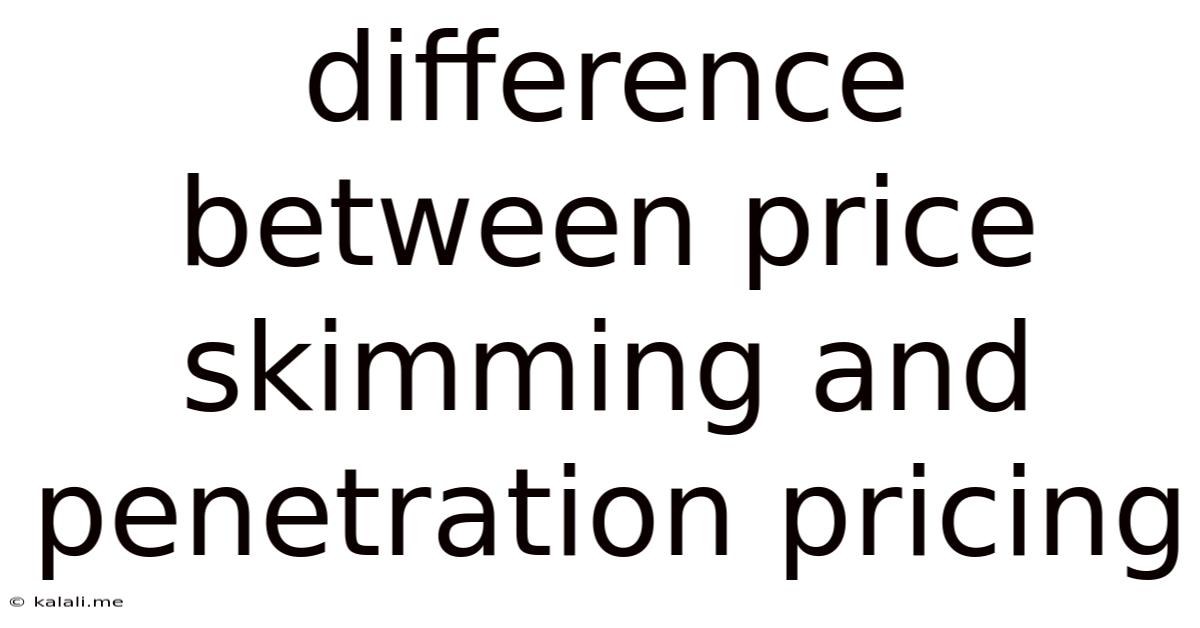Difference Between Price Skimming And Penetration Pricing
Kalali
Jun 11, 2025 · 3 min read

Table of Contents
Price Skimming vs. Penetration Pricing: Choosing the Right Strategy for Your Product
Choosing the right pricing strategy is crucial for the success of any new product launch. Two popular approaches are price skimming and penetration pricing, each with its own advantages and disadvantages. Understanding the core differences between these strategies is key to maximizing your profits and market share. This article will delve into the nuances of each, helping you determine which is best suited for your specific product and market conditions.
What is Price Skimming?
Price skimming involves setting a high initial price for a product, targeting early adopters and those willing to pay a premium for novelty or exclusivity. This strategy is often used for innovative products with little or no direct competition. The high price generates substantial profit margins early on, allowing for recouping development costs quickly. Over time, the price is gradually reduced as competition increases or the product matures.
Advantages of Price Skimming:
- High Profit Margins: Initially, profits are maximized due to the high price point.
- Early Recovery of Development Costs: Quickly recoup investment in research and development.
- Exclusive Image: A high price can create a perception of luxury and exclusivity.
- Market Segmentation: Attracts price-insensitive customers first, allowing for a phased market approach.
Disadvantages of Price Skimming:
- Limited Market Reach: The high price excludes price-sensitive customers.
- Attracts Competition: High profits can incentivize competitors to enter the market quickly.
- Vulnerable to Economic Downturns: High prices can be particularly damaging during economic recession.
- Potential for Lost Sales: Setting the price too high could lead to fewer sales than anticipated.
What is Penetration Pricing?
Penetration pricing involves setting a low initial price for a product to quickly gain a large market share. This strategy is often used for products with many competitors or those entering a highly competitive market. The goal is to attract a large customer base rapidly, even if profit margins are initially lower. The hope is to compensate for low margins through high volume sales.
Advantages of Penetration Pricing:
- Rapid Market Share Growth: Quickly gains significant market presence.
- Economies of Scale: High sales volume leads to lower production costs per unit.
- Strong Brand Loyalty: Attracting customers early builds brand loyalty.
- Barrier to Entry for Competitors: A large market share can deter new entrants.
Disadvantages of Penetration Pricing:
- Low Profit Margins: Initially, profit margins are significantly lower.
- Potential for Losses: If sales volume doesn't meet expectations, losses can occur.
- Price Wars: May trigger price wars with competitors.
- Difficult to Increase Prices Later: Customers may become accustomed to the low price, making price increases challenging.
Key Differences Summarized:
| Feature | Price Skimming | Penetration Pricing |
|---|---|---|
| Initial Price | High | Low |
| Target Market | Early adopters, price-insensitive | Mass market, price-sensitive |
| Goal | Maximize profit margins, recover costs | Gain large market share quickly |
| Profit Margins | High initially, decreases over time | Low initially, increases over time |
| Market Entry | Often for innovative, unique products | Often for competitive markets |
Choosing the Right Strategy:
The best pricing strategy depends on several factors, including:
- Product uniqueness: Is your product innovative and differentiated?
- Competitive landscape: How many competitors exist, and what are their prices?
- Production costs: What are the fixed and variable costs associated with your product?
- Target market: Are your customers price-sensitive or willing to pay a premium?
- Long-term goals: What are your overall business objectives?
Careful market research and analysis are crucial in making this decision. Consider conducting surveys, analyzing competitor pricing, and forecasting demand to determine the most effective approach for your specific product and market. Remember, flexibility is key, and you may need to adjust your pricing strategy over time based on market response.
Latest Posts
Latest Posts
-
How Many Cups Is 12 Oz Of Chocolate Chips
Jul 01, 2025
-
How Do You Beat Level 7 On Bloxorz
Jul 01, 2025
-
What Grade Level Do You Learn Algebra 1
Jul 01, 2025
-
How Long Ago Was The 16th Century
Jul 01, 2025
-
How Many Inches Are In 4 Yards
Jul 01, 2025
Related Post
Thank you for visiting our website which covers about Difference Between Price Skimming And Penetration Pricing . We hope the information provided has been useful to you. Feel free to contact us if you have any questions or need further assistance. See you next time and don't miss to bookmark.